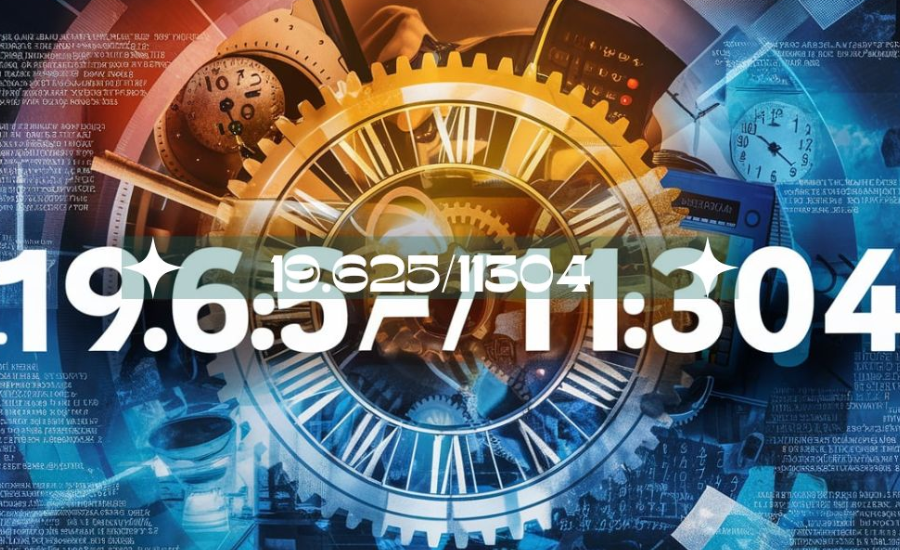19.625/11304: A Step-by-Step Guide to Understanding Complex Fractions
19.625/11304 When working with numerical expressions, particularly those that include decimals and fractions, it can be tricky to fully comprehend their meaning and real-world applications. A specific example is the expression “19.625/11304.” In this discussion, we’ll break down this expression to help you understand not only its value but also its broader significance and potential uses in different scenarios.
Understanding “19.625/11304”: Analyzing the Numbers Step by Step
1.1 Decoding 19.625
To fully understand the expression “19.625/11304,” let’s first break down what 19.625 actually represents.
1.1.1 Understanding the Decimal
The number 19.625 is a decimal, meaning it consists of a whole number (19) and a fractional part (.625), separated by a decimal point.
1.1.2 Converting 19.625 into a Fraction
To gain a clearer understanding, we can convert 19.625 into a fraction.
- The whole number 19 can be expressed as 19/1.
- The decimal .625 can also be transformed into a fraction.
Here’s how to convert .625 into a fraction:
- Express .625 as 625/1000.
- Simplify the fraction by dividing both the numerator and the denominator by their greatest common divisor (GCD), which is 125.
- The simplified fraction becomes 5/8.
Thus, 19.625 as a fraction can be represented as (19 \frac{5}{8}), or more precisely, as ( \frac{157}{8}).
1.2 Understanding 11304
The number 11304 is a simple whole number, or integer, with no fractional part.
1.3 Combining 19.625 and 11304
When we look at the expression “19.625/11304,” we’re essentially dividing 19.625 by 11304. Before we do that, it’s helpful to first convert 19.625 into a fraction, as we’ve done earlier.
This allows us to rewrite the expression as:
[
\frac{\frac{157}{8}}{11304}
]
This complex fraction can be simplified by multiplying 157/8 by the reciprocal of 11304, which is 1/11304:
[
\frac{157 \times 1}{8 \times 11304} = \frac{157}{90432}
]
So, the expression “19.625/11304” simplifies to ( \frac{157}{90432} ).
Simplifying and Interpreting the Fraction

2.1 Simplifying Further
The fraction (\frac{157}{90432}) is already in its most simplified form since 157 is a prime number and has no common factors with 90432.
2.2 Converting to a Decimal
If you find working with decimals easier, you can convert this fraction by dividing 157 by 90432.
[
\frac{157}{90432} \approx 0.001735
]
This shows that “19.625/11304” is approximately equal to 0.001735 in decimal form.
2.3 Converting to a Percentage
To express this result as a percentage, simply multiply the decimal by 100.
[
0.001735 \times 100 \approx 0.1735\%
]
Therefore, “19.625/11304” can also be represented as roughly 0.1735%.
Practical Uses of “19.625/11304” in Real Life
3.1 Applications in Mathematics and Science
Expressions like “19.625/11304” are vital in disciplines such as mathematics, science, engineering, and economics. These ratios can represent probabilities, proportions, or precise scientific measurements where accuracy is key.
3.2 Financial Implications
In finance, similar fractions are commonly used in calculating interest rates, evaluating stocks, and analyzing economic indicators. Mastering the simplification and interpretation of these fractions is crucial for making well-informed financial decisions.
3.3 Everyday Relevance
While such ratios may seem theoretical, they have practical applications in daily life. Whether in cooking (adjusting ingredient proportions), construction (accurate measurements), or analyzing data trends, understanding these ratios can be incredibly useful.
Handling Comparable Fractions and Ratios

4.1 Simplifying Complex Fractions
The method used to decimal number simplify “19.625/11304” can be applied to other complex fractions. Mastering how to convert decimals into fractions and simplify them is essential for both academic pursuits and practical everyday tasks.
4.2 Practical Applications
Here are a few scenarios where similar fractions might be used:
- Recipe Adjustments: If a recipe requires 19.625 cups of flour and you need only a fraction of this amount, such as one 11304th, using the fraction 19.625/11304 helps adjust the quantity precisely.
- Engineering Precision: In engineering, exact measurements are crucial. If a material must be divided into 11304 parts, and each part requires 19.625 units, this fraction helps ensure accurate distribution.
4.3 Using Calculators and Tools
For those who prefer digital solutions, various online calculators can simplify these conversions for you. Nonetheless, understanding the fundamental principles behind these calculations ensures you can verify your results and apply them effectively.
Also Read: 30-105891
Final Words
The expression “19.625/11304” denotes the result of dividing the decimal 19.625 by the integer 11304. To simplify, first convert 19.625 into a fraction, which results in (\frac{157}{8}). When divided by 11304, this becomes (\frac{157}{90432}), a fraction that is already in its simplest form. Converting this fraction to a decimal yields approximately 0.001735, and as a percentage, it is around 0.1735%.
In practical terms, such calculations are essential across various fields. In mathematics and science, they help with precise measurements and proportions. In finance, similar ratios aid in interest calculations and stock evaluations. Even in everyday life, understanding these ratios can help with recipe adjustments and accurate measurements in construction. Mastery of these concepts is crucial for both academic and real-world applications.
FAQs
What does the expression “19.625/11304” represent?
The expression “19.625/11304” signifies dividing the decimal 19.625 by the integer 11304. It simplifies to the fraction 15790432\frac{157}{90432}90432157, which can further be converted to a decimal approximately equal to 0.001735 or about 0.1735% when expressed as a percentage.
How can you convert the decimal 19.625 into a fraction?
To convert 19.625 to a fraction, first separate it into its whole number and decimal parts. The whole number 19 is written as 191\frac{19}{1}119, and the decimal part 0.625 can be expressed as 6251000\frac{625}{1000}1000625. Simplify 6251000\frac{625}{1000}1000625 by dividing both the numerator and the denominator by their greatest common divisor, which is 125, resulting in 58\frac{5}{8}85. Thus, 19.625 as a fraction is 1578\frac{157}{8}8157.
How can I simplify the fraction 15790432\frac{157}{90432}90432157?
The fraction 15790432\frac{157}{90432}90432157 is already in its simplest form. This is because 157 is a prime number and does not have any common factors with 90432 other than 1.
What is the decimal equivalent of the fraction 15790432\frac{157}{90432}90432157?
The decimal equivalent of the fraction 15790432\frac{157}{90432}90432157 is approximately 0.001735.
How do you express the fraction 15790432\frac{157}{90432}90432157 as a percentage?
To express the fraction 15790432\frac{157}{90432}90432157 as a percentage, convert it to a decimal by dividing 157 by 90432 to get approximately 0.001735. Then multiply this decimal by 100, resulting in approximately 0.1735%.
What are some real-world applications of the ratio “19.625/11304”?
The ratio “19.625/11304” can be used in various fields. In mathematics and science, it helps with precise calculations and proportions. In finance, it can aid in interest rate calculations and stock valuations. In everyday life, such ratios are useful for adjusting recipe quantities and making accurate measurements in construction or other practical tasks.
How can similar fractions and ratios be handled in practical situations?
Similar fractions and ratios can be simplified using the same methods applied to “19.625/11304.” This involves converting decimals to fractions, simplifying them, and understanding their practical applications in scenarios such as recipe adjustments or engineering measurements. Using calculators and digital tools can also assist in managing these fractions, but understanding the underlying principles is crucial for accurate results.
Stay updated with the latest news and notifications! Thrill Rise






